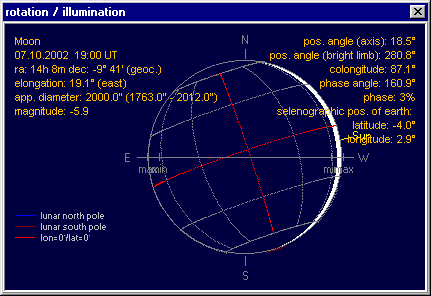Rotation / illumination diagram
 In the Settings
menu, check show object rotation/illumination. A rotation/illumination
window opens showing the geocentric rotation, inclination, illumination, and
variation of apparent size of the object. All information in this window is geocentric
and in UT regardless of the selected location of the observer. The N(orth)–
S(outh) directions are to the celestial poles, the E(ast) – W(est)
directions are parallel to the celestial equator. Move the cursor over the
visibility diagram and the rotation, inclination, illumination, and apparent
size of the body are shown for the selected date and time. Moving the cursor
horizontally shows principally rotation; moving the cursor vertically shows
principally change of inclination, illumination, and apparent size. The
information given in the window, which changes with the motion of the cursor, is
(left column): date, time (UT to 0:04h), geocentric right ascension (to 0:01h) and
declination (to 1'), elongation from the sun (to 0.1°), apparent diameter (to 0.1"),
magnitude (to 0.1); (right column): position angle between the northern
extremity of the axis of rotation and celestial pole measured from north
through east (to 0.1°), phase angle, that is, the elongation of the earth
from the sun measured at the center of the planet, the phase in percent
illumination, and the planetocentric position of the earth: latitude north (+)
and south (-) of the planet's equator, longitude to the east along the
planet's equator with respect to the defined prime meridian of the planet.
For Jupiter longitude is shown for systems I (equator), II (containing great
red spot), and III (radio emissions and magnetic field); for Saturn longitude
is shown for systems I (equator) and III (radio emissions and magnetic
field). These differential rotations are also distinguished in the diagrams
by arcs of meridians. For the sun, the position angle of the axis of rotation
measured from north through east, the heliocentric position of the earth:
latitude north (+) and south (-) of the solar equator, longitude to the east along the solar
equator measured from the solar prime meridian. For the moon, the position
angle of the axis of rotation and position angle of the midpoint of the
bright limb measured from north through east, the colongitude,
that is, the selenographic longitude of the morning
terminator, phase angle (180° - elongation), phase in percent illumination, the selenographic
position of the earth, which shows the librations of the central point of the
lunar disc: in latitude to the north (+) and south (-), in longitude to east
(+) and west (-).
In the Settings
menu, check show object rotation/illumination. A rotation/illumination
window opens showing the geocentric rotation, inclination, illumination, and
variation of apparent size of the object. All information in this window is geocentric
and in UT regardless of the selected location of the observer. The N(orth)–
S(outh) directions are to the celestial poles, the E(ast) – W(est)
directions are parallel to the celestial equator. Move the cursor over the
visibility diagram and the rotation, inclination, illumination, and apparent
size of the body are shown for the selected date and time. Moving the cursor
horizontally shows principally rotation; moving the cursor vertically shows
principally change of inclination, illumination, and apparent size. The
information given in the window, which changes with the motion of the cursor, is
(left column): date, time (UT to 0:04h), geocentric right ascension (to 0:01h) and
declination (to 1'), elongation from the sun (to 0.1°), apparent diameter (to 0.1"),
magnitude (to 0.1); (right column): position angle between the northern
extremity of the axis of rotation and celestial pole measured from north
through east (to 0.1°), phase angle, that is, the elongation of the earth
from the sun measured at the center of the planet, the phase in percent
illumination, and the planetocentric position of the earth: latitude north (+)
and south (-) of the planet's equator, longitude to the east along the
planet's equator with respect to the defined prime meridian of the planet.
For Jupiter longitude is shown for systems I (equator), II (containing great
red spot), and III (radio emissions and magnetic field); for Saturn longitude
is shown for systems I (equator) and III (radio emissions and magnetic
field). These differential rotations are also distinguished in the diagrams
by arcs of meridians. For the sun, the position angle of the axis of rotation
measured from north through east, the heliocentric position of the earth:
latitude north (+) and south (-) of the solar equator, longitude to the east along the solar
equator measured from the solar prime meridian. For the moon, the position
angle of the axis of rotation and position angle of the midpoint of the
bright limb measured from north through east, the colongitude,
that is, the selenographic longitude of the morning
terminator, phase angle (180° - elongation), phase in percent illumination, the selenographic
position of the earth, which shows the librations of the central point of the
lunar disc: in latitude to the north (+) and south (-), in longitude to east
(+) and west (-).